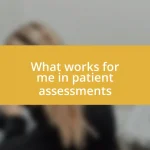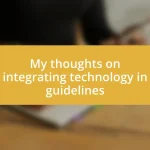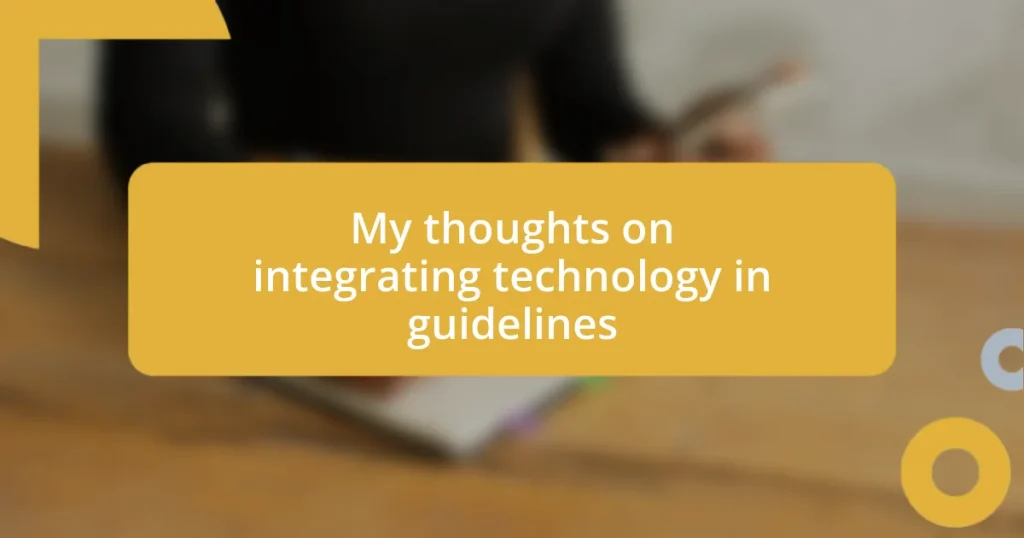Key takeaways:
- Effective patient communication relies on connecting on a human level, using empathy, active listening, and personalized interactions to build rapport and trust.
- Clear and simple language is crucial to ensure patients understand their health and treatment plans, reducing anxiety and fostering open dialogue.
- Continuous feedback from patients enhances communication practices, allowing for adjustments in care that are more aligned with individual needs and improving overall patient engagement.

Understanding patient communication
Effective patient communication goes beyond mere words; it’s about connecting on a human level. I remember a time when I spoke with a patient who was overwhelmed by their diagnosis. Instead of jumping straight into treatment options, I first took the time to listen to their fears and concerns. This approach not only built trust but also made it easier for us to discuss next steps together.
When we think about patient communication, it’s important to consider how nonverbal cues can speak volumes. I once observed a nurse who always made eye contact and maintained an open posture, which immediately put patients at ease. Have you ever noticed how a simple smile can brighten someone’s day? In healthcare, these little gestures can transform a sterile environment into a supportive haven, fostering better dialogue and understanding.
Ultimately, understanding patient communication means recognizing that each individual has unique feelings and experiences. I often reflect on how one patient expressed feeling unheard during past visits. This personal revelation reinforced my belief that taking the time to ask open-ended questions and truly engage can make all the difference in a patient’s healthcare journey. What strategies have you found to be effective in making patients feel valued and understood?

Building rapport with patients
Building rapport with patients is a vital component of effective communication. I’ve seen how a genuine approach melts away the barriers that often exist in a clinical setting. One day, I spent an extra few minutes just chatting with a new patient about their favorite hobbies. As we laughed over shared interests, I noticed their initial unease fading. This small act of connection encouraged them to open up about their health concerns, making our discussion more productive and meaningful.
To foster this connection, I’ve found a few simple strategies to be incredibly effective:
- Be present: Focus on the patient without distractions. Put away your phone and give them your full attention.
- Use their name: Personalizing the conversation helps create familiarity and trust.
- Empathetic listening: Acknowledge their feelings. I often echo their concerns back to them to show I understand.
- Shared experiences: Relating on a human level, even in small ways, can build camaraderie.
- Respect their time: Breaking the ice can be quick. I often ask about their day as I enter the room—every moment counts.
These practices not only enhance communication but also enrich the patient’s experience, transforming a transactional interaction into a supportive relationship.

Active listening techniques
Active listening is a cornerstone of effective patient communication, and I’ve found that employing specific techniques can truly enhance this process. One of the most impactful strategies I’ve utilized is reflective listening, where I repeat back what a patient has shared with me. For instance, after a patient expressed anxiety about starting a new treatment, I paraphrased their concerns, which not only validated their feelings but also opened the door for deeper exploration. This level of engagement shows patients that I genuinely care about their experience.
Another technique that has transformed my interactions is the use of clarifying questions. I recall a moment when a patient described a symptom in a way I found somewhat vague. Instead of assuming, I gently asked for more details, which uncovered vital information that changed our approach to treatment. By demonstrating curiosity and concern, I’m able to foster trust and further empower my patients to share openly, which ultimately leads to more tailored and effective care.
Incorporating nonverbal cues into active listening is equally important. I make a conscious effort to maintain eye contact and nod along, signaling that I’m fully engaged. This not only puts patients at ease but also encourages them to communicate more freely. When I focus on being present in our conversation—removing distractions and actively engaging—I often see the stress and tension melt away, allowing for a more fruitful dialogue.
| Active Listening Technique | Description |
|---|---|
| Reflective Listening | Paraphrasing what a patient says helps validate their feelings and encourages further dialogue. |
| Clarifying Questions | Asking open-ended questions to ensure you fully understand their concerns can uncover critical information. |
| Nonverbal Cues | Maintaining eye contact and nodding shows engagement, putting patients at ease and promoting open communication. |

Clear and simple language
One of the most impactful changes I made in my communication style was to prioritize clear and simple language. I recall a particular instance when a patient looked more confused than before our conversation. I had used medical jargon, thinking it would help clarify the procedure they needed, but instead, it only added to their anxiety. That experience taught me that simplifying my language creates a foundation for trust, ensuring patients truly understand their health.
Using straightforward words isn’t just about avoiding complex terminology; it’s about connecting on a human level. For instance, instead of saying “administration of medication,” I now simply say “taking your medicine.” It may seem trivial, but these small shifts make my patients feel more comfortable and less intimidated. Have you ever noticed how much easier it is to talk about personal issues when the language is relatable? This realization has reinforced my commitment to speaking directly and clearly, allowing patients to engage more openly in their care processes.
I often find myself asking, “Would I understand this if I were in their shoes?” Before explaining a diagnosis or treatment plan, I visualize myself as the patient, which helps me gauge the clarity of my explanations. This empathetic approach not only cultivates a supportive environment but also empowers patients to ask questions and express their concerns without hesitation. When language is clear, the barriers come down, and meaningful dialogue can flourish.

Nonverbal communication cues
Nonverbal communication cues play a crucial role in how I connect with my patients. I’ve often noticed how a simple smile can instantly ease a patient’s anxiety. For example, during a particularly tense consultation, I leaned slightly forward, maintained warm eye contact, and flashed a reassuring smile as I explained the treatment plan. It was almost magical to witness their body language shift — visibly relaxing and opening up to discussions that followed.
Another significant nonverbal cue I utilize is my posture. When I sit at eye level with my patients, it conveys empathy and approachability. I remember a time when a parent expressed concern about their child’s diagnosis. By turning my body towards them rather than adopting a more distant stance, I created a safe space for them to feel valued and understood. Did you know that just the way you position yourself can influence a patient’s willingness to engage? It’s fascinating how our bodies often speak louder than our words.
Lastly, I can’t overlook the power of silence paired with attentive listening. In a consultation with a patient who had just received bad news, I intentionally held back from rushing to fill the silence right away. Instead, I offered my presence, letting them process their thoughts and emotions. In that stillness, I witnessed them gather the courage to ask deeply personal questions. This taught me that nonverbal cues are not just about actions; they also include creating space for emotions and allowing patients to lead the conversation when they’re ready.

Personalizing patient interactions
Personalizing patient interactions goes beyond just using names; it’s about crafting a relational experience that resonates with each individual. I remember a moment when I called a long-time patient by their nickname instead of their formal name. The smile that spread across their face was immediate and contagious, breaking down the usual barrier that often hovers in clinical settings. This small gesture transformed our conversation, making it feel more like a chat between friends rather than a sterile appointment. Have you ever realized how a simple personal touch can radically change someone’s mood?
Engaging patients on a personal level means I often dig deeper to understand their interests and backgrounds. When a patient mentioned their love for gardening, I found a way to weave that passion into our discussion about their health. I said, “Just like nurturing a plant, you’ll see the benefits of nurturing your body too.” This created a beautiful bridge between their passion and their health journey, making it easier for them to see the relevance of my advice. It’s moments like these that remind me how impactful personalization can be in healthcare.
I truly believe that everyone has a story. During one consultation, I took a moment to ask my patient about their family, which opened up a dialogue about their motivation for making health changes. I could see the pride in their eyes as they spoke about their children. This personal connection ignited a sense of shared purpose, making them more committed to following through with the treatment plan. Isn’t it incredible how understanding someone’s life can foster not only trust but also a collaboration in their health journey?

Continuous feedback and improvement
When I think about continuous feedback in patient communication, I can’t help but recall a particular instance when a patient voiced concerns about the medication I prescribed. Instead of brushing off their hesitations, I welcomed their feedback, asking open-ended questions to clarify their fears. That simple act not only empowered them but also led me to adjust the treatment plan in a way that felt more comfortable for them. It was a win-win: they felt heard, and I learned a bit more about tailoring care to individual needs. Have you ever experienced a moment when listening changed the course of a conversation?
Improvement in communication doesn’t happen in isolation; it requires a cycle of observation, feedback, and action. For instance, I once conducted a short survey after consultations to gauge patients’ understanding of instructions provided during the visit. The results were eye-opening! Many patients expressed confusion about follow-up care. By addressing this gap directly, I modified my approach and found that allowing additional time for questions made a significant difference in their engagement. Reflecting on ways to improve by gathering insights really does transform practices and builds trust.
I’ve learned that fostering a culture of continuous feedback is essential not just for patients, but also for myself as a healthcare professional. In our team meetings, we often share patient stories, both successes and challenges, fostering an environment where learning is encouraged. I vividly remember discussing a particularly challenging case, where we collectively brainstormed solutions that I later implemented in my future interactions. It highlighted the importance of collaboration—when we share experiences and feedback, it enhances our ability to serve patients effectively. Isn’t it remarkable how collective wisdom can elevate our practice to new heights?













